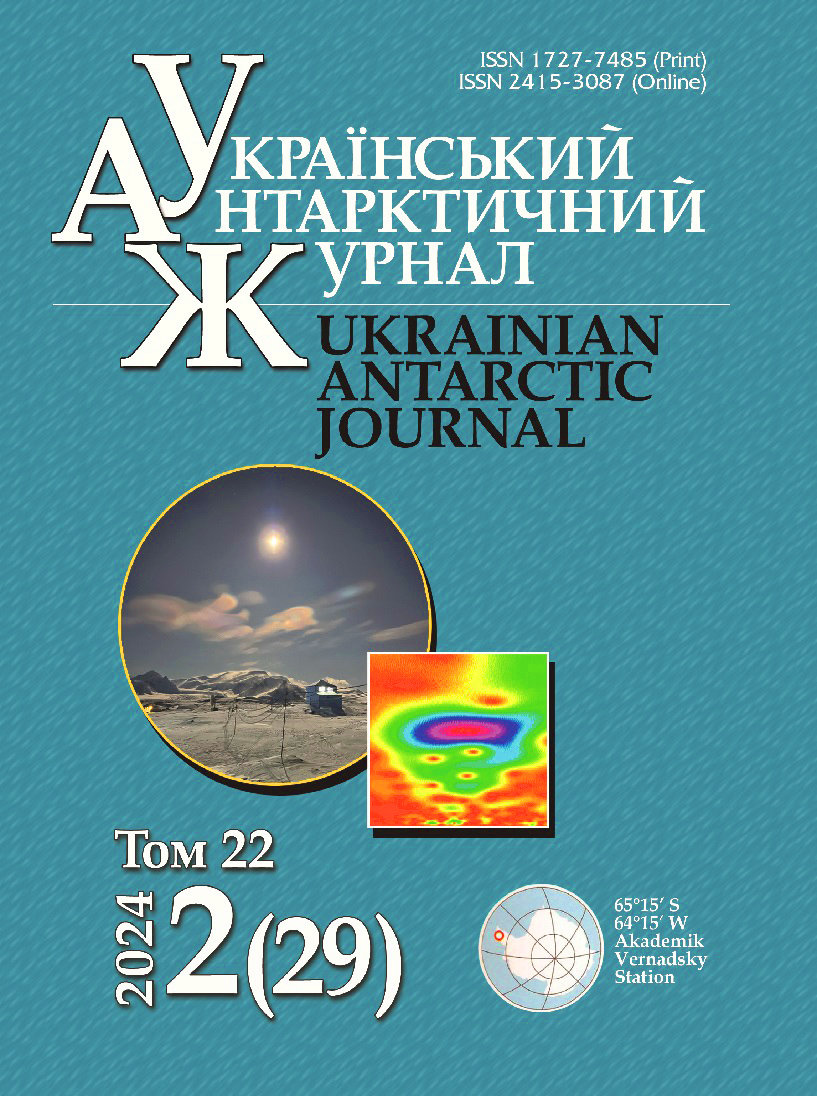Вплив поверхневих хвиль південноамериканських землетрусів на льодовиковий покрив Антарктичного півострова
- кріосейсміка,
- льодовики,
- магнітуда,
- сейсмологія
Авторське право (c) 2024 Український антарктичний журнал

Ця робота ліцензується відповідно до Creative Commons Attribution-NonCommercial-NoDerivatives 4.0 International License.
Анотація
Землетруси породжують коливання поверхні геологічного середовища, яке має руйнівний ефект для льодовикового покриву Антарктиди. У результаті взаємодії сейсмічних хвиль з льодовиком в ньому з’являється додаткова тріщинуватість, підвищується його рухливість та текучість. Ці процеси пришвидшують зменшення загальної маси льодового покриву західної Антарктиди. Метою публікації є аналіз фізичного впливу на льодовики землетрусів, які були зареєстровані на антарктичній станції «Академік Вернадський», та опосередкованого виявлення наслідків руйнування цілісної структури льодовика, які супроводжуються появою викликаної сейсмічності. Для аналізу реакції льодової товщі на землетрус були відібрані найбільш характерні хвильові поля від різних сейсмічно активних зон навколо о. Галіндез. Проведено аналіз прискорення поверхні ґрунту для короткочасних землетрусів та часу, впродовж якого льодовики знаходилися під впливом коливних явищ. Щоб уникнути сумарного ефекту від поперечних, повздовжніх та поверхневих хвиль були використані сейсмічні дані від максимально віддаленого Перуанського землетрусу з магнітудою 7.2, який відбувся 2022-05-26 о 12:02:21 UTC. Сейсмічні хвилі різних типів приходять у точку спостереження у різний час через велику відстань та різну швидкість розповсюдження хвиль. Це виокремлює їх у часі, що дозволяє вивчати взаємодію кожного типу хвилі і льодовика. В публікації проаналізовано дію довгоперіодної поверхневої хвилі на товщу острівних льодовиків, які знаходяться на невеликій відстані від о. Галіндез. Встановлено, що викликана кріосейсмічність проявляється у високочастотній області сейсмічних записів низкою імпульсів, які пов’язують з утворенням тріщин та розломів у льодовиках. Використовувались дані сейсмостанції Guralp CMG 40-TDE, єдиної на території антарктичної станції «Академік Вернадський». Наявні сейсмічні дані дозволили виявити причинно-наслідковий зв'язок землетрусів та кріосейсміки, однак не дозволяють визначити просторове розташування виявлених подій. Проведено аналіз хвильових полів-завад, які характерні для о. Галіндез та ускладнюють процедуру виявлення цільових (поверхневих) хвиль.
Посилання
- Anthony, R. E., Aster, R. C., Wiens, D., Nyblade, A., Anandakrishnan, S., Huerta, A., Winberry, J. P., Wilson, T., & Rowe, C. (2015). The seismic noise environment of Antarctica. Seismological Research Letters, 86(1), 89–100. https://doi.org/10.1785/0220140109
- Aster, R. C., & Winberry, J. P. (2017). Glacial seismology. Reports on Progress in Physics, 80(12), 126801. https://doi.org/10.1088/1361-6633/aa8473
- Båth, M. (1974). Spectral Analysis in Geophysics. Elsevier.
- Brinkman, N., Sollberger, D., Schmelzbach, C., Stähler, S. C., & Robertsson, J. (2023). Applications of time-frequency domain polarization filtering to InSight seismic data. Earth and Space Sciense,10(11), 1–17. https://doi.org/10.1029/2023EA003169
- Camelbeeck, T., Lombardi, D., Collin, F., Rapagnani, G., Martin, H., & Lecocq, T. (2017). Contribution of the seismic monitoring at the Belgian Princess Elisabeth base to East Antarctica ice sheet dynamics and global seismicity studies. Bulletin des Séances de Académie Royale des Sciences d’Outre-Mer, 63(2017-1), 163–178. https://doi.org/10.5281/zenodo.3693877
- Cannata, A., Larocca, G., Del Carlo, P., Giudice, G., Giuffrida, G., Liuzzo, M., Zuccarello, L., Di Grazia, G., Gambino, S., Privitera, E., Delladio, A., & Grigioni, P. (2017). Characterization of seismic signals recorded in Tethys Bay, Victoria Land (Antarctica): data from atmosphere-cryosphere-hydrosphere interaction. Annals of Geophysics, 60(5), S0555. https://doi.org/10.4401/ag-7408
- Civile, D., Lodolo, E., Vuan, A., & Loreto M. F. (2012). Tectonics of the Scotia–Antarctica plate boundary constrained from seismic and seismological data. Tectonophysics, 550–553, 17–34. https://doi.org/10.1016/j.tecto.2012.05.002
- Davison, B. J., Hogg, A. E., Gourmelen, N., Jakob, L., Wuite, J., Nagler, T., Greene, C. A., Andreasen, J., & Engdahl, M. E. (2023). Annual mass budget of Antarctic ice shelves from 1997 to 2021. Science Advances, 9, 1–12. https://doi.org/10.1126/sciadv.adi0186
- Feenstra, J., Hull, A., Li, F., Fraser, J., Howard, M., & McMorran, T. (2019). Estimating seismic hazard with Sparse Data: Seismic sourse model and sensitivity of a PSHA for Palmer Station, Antarctica. 2019 Pacific Conference on Earthquake Engineering and Annual NZSEE Conference, 4–6 April 2019, New Zealand.
- Giner-Robles, J. L., Pérez-López, R., Rodríguez-Pascua, M. A., Martínez-Díaz, J. J., & González-Casado, J. M. (2009). Present-day strain field on the South American slab underneath the Sandwich Plate (Southern Atlantic Ocean): A kinematic model. Geological Society, London, Special Publications, 328(1), 155–167. https://doi.org/10.1144/SP328.6
- Govers, R., Broerse, T., & Herman, M. (2021). Tectonic context of the August 2021 South Sandwich Islands earthquake sequence: plate boundary geometry and kinematics at active STEPs. AGU Fall Meeting 2021, New Orleans, LA, 13–17 December 2021. https://doi.org/10.1002/essoar.10509096.1
- Greenhalgh, S., Sollberger, D., Schmelzbach, C., & Rutty, M. (2018). Single-station polarization analysis applied to seismic wavefields: A tutorial. Advances in Geophysics, 59, 123–170. https://doi.org/10.1016/bs.agph.2018.09.002
- Gryn, D. (2023). Seismic hazard of the territory of Ukraine: according to the materials of scientific report at the meeting of the Presidium of NAS of Ukraine, March 8, 2023. Visnyk of the National Academy of Sciences of Ukraine, (6), 25–33. https://doi.org/10.15407/visn2023.06.025
- Jennings, S. J. A., & Hambrey, M. J. (2021). Structures and deformation glaciers and ice sheets. Reviews of Geophysics, 59, e2021RG000743. https://doi.org/10.1029/2021RG000743
- Jia, Z., Zhan, Z., & Kanamori, H. (2022). The 2021 South Sandwich Island Mw 8.2 earthquake: a slow event Sandwiched between regular ruptures. Geophysical Research Letters, 49(3), e2021GL097104. https://doi.org/10.1029/2021GL097104
- Köhler, A., Maupin, V., Nuth, C., & van Pelt, W. (2019). Characterization of seasonal glacial seismicity from a single-station on-ice record at Holtedahlfonna, Svalbard. Annals of Glaciology, 60(79), 23–36. https://doi.org/10.1017/aog.2019.15
- Li, C., Peng, Z., Chaput, J. A., Walter, J. I., & Aster, R. C. (2021). Remote triggering of icequakes at Mt. Erebus, Antarctica by large teleseismic earthquakes. Seismological Research Letters, 92(5), 2866–2875. https://doi.org/10.1785/0220210027
- Li, W., Chen, J., Lu, H., Yu, C., Shan, Y., Li, Z., Dong, X., & Xu, Q. (2023). Analysis of seismic impact on Hailuogou Glacier after the 2022 Luding Ms 6.8 earthquake, China, using SAR offset tracking technology. Remote Sensing, 15, 1468. https://doi.org/10.3390/rs15051468
- Li, Z., Sun, J., Gao, M., Fu, G., An, Z., Zhao, Y., Fang L., & Guo, X. (2022). Evaluation of horizontal ground motion waveforms at Sedongpu Glacier during the 2017 M6.9 Mainling earthquake based on the equivalent Green’s function. Engineering Geology, 306, 106743. https://doi.org/10.1016/j.enggeo.2022.106743
- Liashchyk, O. I., & Karyagin, Ye. V. (2018). Features of seismicity in the Argentine Islands Archipelago region due to the prosses of icebergs formation. Ukrainian Antarctic Journal, (1(17)), 32–39. https://doi.org/10.33275/1727-7485.1(17).2018.29
- Liu, Q., Zhang, B., Zhao, B., Zhong, Y., Lu, X., & Zhou, J. (2022). Stability of the Hailuogou glacier during the “9.5” Luding Earthquake: a preliminary assessment based on multi-source observations. Journal of Mountain Science, 19, 3037–3050. https://doi.org/10.1007/s11629-022-7730-x
- Lough, A. C., Barcheck, C. G., Wiens, D. A., Barklage, M. E., Nyblade, A., Aster, R. C., Anandakrishnan, S., Huerta, A. D., & Wilson, T. J. (2011). Detection of seismic sources associated with ice movement in Antarctica using POLENET seismic array, AGAP seismic array, and GSN seismic stations. AGU Fall Meeting 2011, id. C41D-0433.
- McBrearty, I. W., Zoet, L. K., & Anandakrishnan, S. (2020). Basal seismicity of the Northeast Greenland Ice Stream. Journal of Glaciology, 66(257), 430–446. https://doi.org/10.1017/jog.2020.17
- Paolo, F. S., Fricker, H. A., & Padman, L. (2015). Volume loss from Antarctic ice shelves is accelerating. Science, 348(6232), 327–331. https://doi.org/10.1126/science.aaa0940
- Peng, Z., Walter, J. I., Aster, R. C., Nyblade, A., Wiens, D. A., & Anandakrishnan, S. (2014). Antarctic icequakes triggered by the 2010 Maule earthquake in Chile. Nature Geoscience, 7(9), 677–681. https://doi.org/10.1038/ngeo2212
- Pinnegar, C. R. (2006). Polarization analysis and polarization filtering of three-component signals with the time–frequency S transform. Geophysical Journal International, 165(2), 596–606. https://doi.org/10.1111/j.1365-246X.2006.02937.x
- Reading, A. M. (2007). The seismicity of the Antarctic plate. In S. Stein, & S. Mazzotti, Continental Intraplate Earthquakes: Science, Hazard, and Policy Issues (pp. 285–298). Geological Society of America. https://doi.org/10.1130/2007.2425(18)
- Ringler, A. T., Anthony, R. E., Aster, R. C., Ammon, C. J., Arrowsmith, S., Benz, H., Ebeling, C., Frassetto, A., Kim, W.-Y., Koelemeijer, P., Lau, H. C. P., Lekić, V., Montagner, J. P., Richards, P. G., Schaff, D. P., Vallée, M., & Yeck, W. (2022). Achievements and prospects of global broadband seismographic networks after 30 years of continuous geophysical observations. Reviews of Geophysics, 60, e2021RG000749. https://doi.org/10.1029/2021RG000749
- Schepers, G., van Hinsbergen, D. J. J., Spakman, W., Kosters, M. E., Boschman, L. M., & McQuarrie, N. (2017). South-American plate advance and forced Andean trench retreat as drivers for transient flat subduction episodes. Nature Communications, 8, 15249. https://doi.org/10.1038/ncomms15249
- Smalley, R., Bevis, M., & Dalziel, I. (2021). Tectonic setting of the 2021 earthquake doublet in the South Sandwich-South America convergent plate boundary system. AGU Fall Meeting 2021, New Orleans, LA, 13–17 December 2021, id. S42C-07.
- Stein, S., Engeln, J. F., DeMets, C., Gordon, R. G., Woods, D., Lundgren, P., Argus, D., Stein, C., & Wiens, D. A. (1986). The Nazca-South America convergence rate and the recurrence of the Great 1960 Chilean Earthquake. Geophysical Research Letters, 13(8), 713–716. https://doi.org/10.1029/GL013i008p00713
- Su, Y., & Liu, E. l. (2019). Numerical simulation of dynamic analysis of glacier under seismic loading based on combined finite-discrete method. IOP Conference Series: Earth and Environmental Science, 283, 012064. https://doi.org/10.1088/1755-1315/283/1/012064
- Sykes, L. R. (2021). Decadal seismicity before great earthquakes—strike-slip faults and plate interiors: major asperities and low-coupling zones. International Journal of Geosciences, 12(9), 784–833. https://doi.org/10.4236/ijg.2021.129044
- Taylor, F. W., Bevis, M. G., Dalziel, I. W. D., Smalley Jr., R., Frohlich, C., Kendrick, E., Foster, J., Phillips, D., & Gudipati, K. (2008). Kinematics and segmentation of the South Shetland Islands-Bransfield basin system, northern Antarctic Peninsula. Geochemistry, Geophysics, Geosystems, 9(4), 1–7. https://doi.org/10.1029/2007GC001873
- Tsuboi, S., Kikuchi, M., Yamanaka, Y., & Kanao, M. (2000). The March 25, 1998 Antarctic Earthquake: Great earthquake caused by postglacial rebound. Earth, Planets and Space, 52, 133–136. https://doi.org/10.1186/BF03351621
- van de Lagemaat, S. H. A., Swart, M. L. A., Vaes, B., Kosters, M. E., Boschman, L. M., Burton-Johnson A., Bijl, P. K., Spakman, W., & van Hinsbergen, D. J. J. (2021). Subduction initiation in the Scotia Sea region and opening of the Drake Passage: When and why? Earth-Science Reviews, 215, 1–25, 103551. https://doi.org/10.1016/j.earscirev.2021.103551
- Walter, J. I., Peng, Z., Tulaczyk, S. M., & Oneel, S. (2013). Triggering of glacier seismicity (icequakes) by distant earthquakes. American Geophysical Union, Spring Meeting 2013, id. C24A-02
- Wang, Y. (2022). Time-frequency analysis of seismic signals. John Wiley & Sons, Ltd. https://doi.org/10.1002/9781119892373
- Xie, J., Zeng, X., Liang, C., Ni, S., Chu, R., Bao, F., Lin, R., Chi, B., & Lv, H. (2024). Ice plate deformation and cracking revealed by an in situ-distributed acoustic sensing array. The Cryosphere, 18, 837–847. https://doi.org/10.5194/tc-18-837-2024
- Yegorova, T., Bakhmutov, V., Janik, T., & Grad, M. (2011). Joint geophysical and petrological models for the lithosphere structure of the Antarctic Peninsula continental margin. Geophysical Journal International, 184(1), 90–110. https://doi.org/10.1111/j.1365-246X.2010.04867.x


